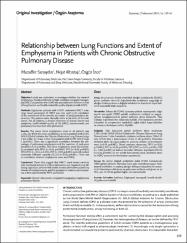| dc.contributor.author | Sarıaydın, Muzaffer | |
| dc.contributor.author | Altıntaş, Nejat | |
| dc.contributor.author | İnce, Özgür | |
| dc.date.accessioned | 2022-05-11T14:39:47Z | |
| dc.date.available | 2022-05-11T14:39:47Z | |
| dc.date.issued | 2014 | |
| dc.identifier.issn | 2148-3620 | |
| dc.identifier.issn | 2148-5402 | |
| dc.identifier.uri | https://doi.org/10.5152/ejp.2014.98608 | |
| dc.identifier.uri | https://hdl.handle.net/20.500.11776/8718 | |
| dc.description.abstract | Objective: A study was undertaken to investigate whether the extent of emphysema, visually confirmed by high-resolution computed tomography (HRCT), in patients with COPD was associated with different indices of lung function and health-related life quality of patients with COPD. Methods: Eighty-two patients with COPD underwent HRCT scanning; visual assessment of HRCT scan was used in the calculation of the assessment of the severity and extent of emphysematous destruction. The patients were clinically stable at the time of the evaluation. For all subjects, a detailed interview of disease history and symptoms, health-related quality of life (HRQL) measurement, and pulmonary function tests were performed. Results: The mean visual emphysema score in all patients was 2.10 +/- 1.26. While the mean emphysema score in patients with COPD GOLD (Global Initiative for Chronic Obstructive Lung Disease) stage 3 was 2.88 +/- 1.01, it was 1.54 +/- 1.13 in patients with COPD GOLD stage 2 (p<0.001). There was a significant correlation between the percentage of pulmonary emphysema and the numbers of pack-years smoked (r=0.58, p<0.001). The visual emphysema score was inversely correlated with FEV1 (r=-0.56, p<0.0001), FVC (r=-0.38, p<0.001), FEV1/FVC (r=-0.43, p<0.001), PEF (r=-0.44, p<0,001) and with carbon monoxide diffusion capacity (DLCO) (r=-0.50, p<0.001). There was no correlation between emphysema score and SGRQ. Conclusion: These data suggest that HRCT visual scores correlate with functional indices of airflow obstruction and impaired lung diffusing capacity in patients with stable chronic obstructive pulmonary disease of varying severity, and the presence of pulmonary emphysema is best represented by FEV1 and DLCO. | en_US |
| dc.language.iso | eng | en_US |
| dc.publisher | Aves | en_US |
| dc.identifier.doi | 10.5152/ejp.2014.98608 | |
| dc.rights | info:eu-repo/semantics/openAccess | en_US |
| dc.subject | Chronic obstructive | en_US |
| dc.subject | computed tomography | en_US |
| dc.subject | emphysema | en_US |
| dc.subject | pulmonary disease | en_US |
| dc.title | Relationship between Lung Functions and Extent of Emphysema in Patients with Chronic Obstructive Pulmonary Disease | en_US |
| dc.type | article | en_US |
| dc.relation.ispartof | Eurasian Journal of Pulmonology | en_US |
| dc.department | Fakülteler, Tıp Fakültesi, Dahili Tıp Bilimleri Bölümü, Göğüs Hastalıkları Ana Bilim Dalı | en_US |
| dc.identifier.volume | 16 | en_US |
| dc.identifier.issue | 3 | en_US |
| dc.identifier.startpage | 159 | en_US |
| dc.identifier.endpage | 163 | en_US |
| dc.institutionauthor | Altıntaş, Nejat | |
| dc.relation.publicationcategory | Makale - Uluslararası Hakemli Dergi - Kurum Öğretim Elemanı | en_US |
| dc.identifier.wos | WOS:000421899100005 | en_US |



















